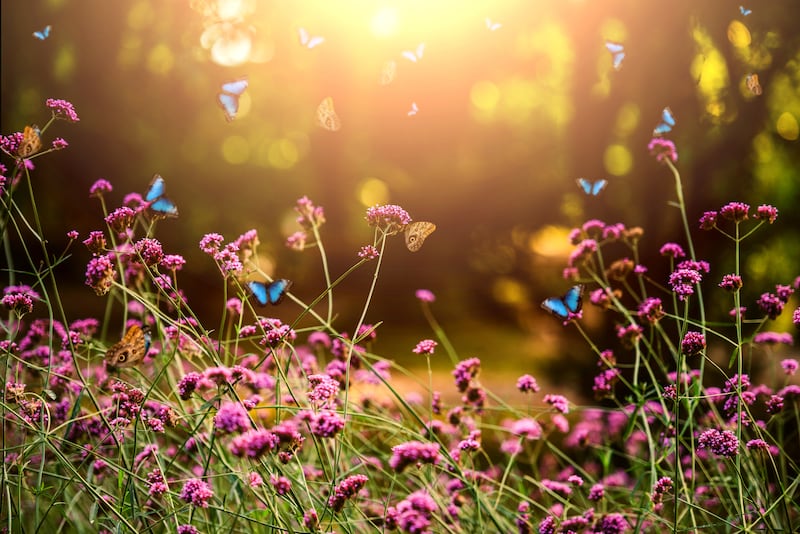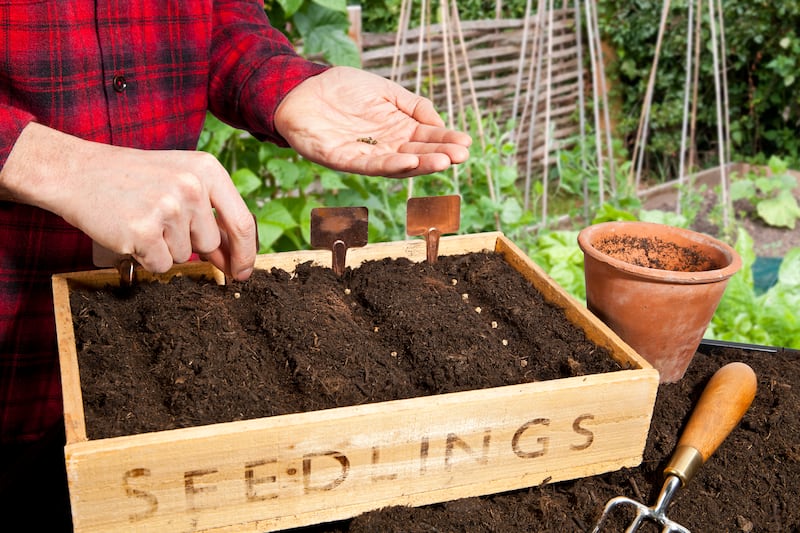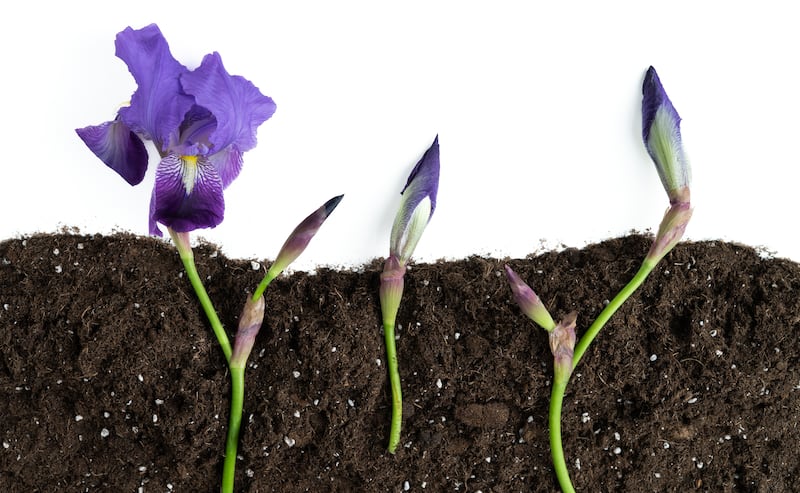I’ve always loved-hated this time of year, perched on the very edge of summer, watching the garden bit by tiny bit being silently gilded with the soft shimmer of an Irish autumn. Seeds are forming, fruit ripening, fields filling with golden bales, while butterflies have begun to flit indoors through open windows to overwinter, signs that nature is slowly but surely shifting gear.
Late August, of course, is the time of year when our allotments, gardens, glasshouses and polytunnels are traditionally laden with fresh flowers and home-grown produce. But it’s also the time to plan ahead for the leaner months of winter and early spring. Miss the boat when it comes to sowing seeds of certain flowers and edible crops, for example, and you’ll regret it. Put off ordering favourite varieties of late winter and spring-flowering bulbs and you may be too late. With that in mind, here’s a few useful pointers to help you get started.
Sow some hardy annuals
Strange as it may seem, late August to late September is a great time of the year to start sowing seed of many different kinds of flowering hardy annuals to give you lots of luscious colour in the garden next summer. Don’t worry, this resilient group of plants will happily tolerate an average Irish winter, while an early autumn sowing will give you larger, more resilient, more floriferous plants than those raised from seed sowed in spring. The list of suitable candidates includes the graceful umbellifer known as ammi (both Ammi majus and Ammi visnaga), bee-friendly honeywort (Cerinthe), cornflowers (Centaurea cyanus), Chinese forget-me-not (Cynoglossum amabile), Love-in-a-mist (Nigella, direct-sow only), edible pot marigolds (Calendula), Orlaya grandiflora, corncockle (Agrostemma githago) and Californian poppies. At this time of year you can either direct-sow the seed into well-prepared, moist, weed-free soil or sow into pots/ deep trays for transplanting out into the garden by October. Recommended Irish seed suppliers include all good Irish garden centres as well as specialist online suppliers such as seedaholic.com. Sweet pea are the exception. Instead it’s best to hold off sowing seed of these sweetly-scented hardy annual climbers until late October/November.
READ MORE

Order spring-flowering bulbs
Every year I remind myself of that saying, “the early bird catches the best worm”, when it comes to ordering bulbs of my favourite varieties of spring-flowering bulbs. And then almost every year I curse myself for not doing it in time to bag the ones I most want.
Inevitably, for example, there’s only limited stock of the most desirable varieties such as the exquisite Tulip “Belle Epoque” (dusty apricot, double-flowers) and Tulip “Ridgedale” (deep-rose, double flowers). The same is true of many of the most popular varieties of narcissus, fritillaria, allium, erythronium, muscari and hyacinths, just some of the many kinds of plants that can be planted as bulbs over the coming months to give brilliant colour in the garden next spring. Growing them couldn’t be simpler. Just bury the bulbs in the ground or in containers to the recommended depth and up they’ll come. Recommended Irish suppliers include mrmiddleton.com ; fruithillfarm.com ; and bulbs.ie as well as all good Irish garden centres, while the UK-based peternyssen.com will also deliver to Ireland.

Leafy greens
This is also an excellent time of the year to sow seed of overwintering winter salad crops and other hardy leafy vegetables while soil temperatures are still warm and light levels are relatively high, resulting in good germination rates and swift, healthy root development. Suitable candidates include landcress, lambs lettuce, hardy/winter lettuce varieties such as “Winter Density”, chard, chicory, winter purslane (claytonia), rocket, oriental mustards “Red Frills’ and ‘Green Wave’, mibuna, mizuna, tatsoi, pak choi, choy sum, komatsuna and spring cabbage.
All of these crops will enjoy the protective environment of a polytunnel or glasshouse, but you can also grow them well outdoors under a snug winter blanket of horticultural fleece. To protect the freshly-sowed seed from high temperatures at this time of year (the latter can sometimes inhibit germination or cause problems with premature bolting), sow it outdoors in the cool of the evening into seed trays or modules filled with a good-quality seed compost or into well-prepared, pre-watered seedbeds for transplanting young plants into their final positions later in autumn.
Recommended Irish seed suppliers include greenvegetableseeds.com, seedaholic.com ; quickcrop.ie ; giy.ie ' fruithillfarm.com and the organically-certified Irish seed producer brownenvelopeseeds.com while the Dublin-based organic gardener Nicky Kyle’s excellent blog at nickykylegardening.com gives loads of monthly expert tips on growing vegetables in Ireland throughout winter.
Bare soil is bad soil
It’s all too easy to leave recently-emptied vegetable beds untended over the coming months, but the inevitable result will be a crop of weeds and a steep drop-off in soil fertility. Instead, either cover the bare ground with an organic mulch of well-rotted manure, fresh seaweed or home-made garden compost or sow a green manure for strimming/digging back into the ground later. Both will suppress weed germination, protect soil health, help to replenish lost nutrients and revitalise essential beneficial soil micro-organisms. Suitable green manure varieties to sow at this time of year include phacelia, buckwheat, mustard, winter vetch/ tares field beans, Japanese oats and clover. Just as you would with any sowing, prepare the ground in advance by lightly forking it over, then raking it and pre-watering it. Seed of these nature-friendly green manures is available from most good Irish garden centres while an extensive range is available to order online from fruithillfarm.

Start propagating plants for free
From home-saving seed to taking cuttings of herbs, perennials and woody plants, the late summer garden offers so many possibilities to grow your own plants for free. The country’s flower beds, borders and summer containers are filled with ripe, viable seed at this time of year that can be very easily harvested and stored in a cool, dry, dark place until needed. The same is true of many kinds of herbs and vegetables. Just make sure to harvest on a dry, still day, placing the seed into clearly-labelled paper bags or envelopes rather than shoving them into your pockets and forgetting all about them. For more details and tips on home seed-saving, see seedsavers.
Likewise, semi-hardwood cuttings taken at this time of year will produce lots of young viable plants for your garden or allotment or to give away to family and friends or plant sales in aid of charities and gardening clubs. Just make sure to place the freshly-taken cuttings into a plastic bag to which you’ve added a little water, keep them away from heat and bright sunlight and then prep them as soon as possible to preserve their freshness as this dramatically up the chances of them successfully rooting. Don’t forget to label them too. For step-by-step instructions on taking cuttings, see my column earlier this year.
This week in the garden
The recent heavy rainfall has done a lot to revitalise weary, heatwave-battered plants but for even better results, spend some time deadheading faded flowers, removing dead, damaged or diseased leaves and then finish off with a liquid seaweed feed. Summer containers that were badly hit by the record heat levels can be refreshed with some judicious replanting to fill the gaps left by dead plants. Suitable candidates that will provide plenty of autumn colour include dahlias, salvias, pelargoniums, bidens, rudbeckia and hytotelephium (sedum).
Blight is much more of a risk in this damp, muggy weather so keep a careful eye out for signs of this damaging fungal disease on potato and tomato plants. For the same reason, tomato plants grown under cover should only be watered around the base of the plants to avoid creating the kind of conditions where the disease can take hold. Signs of blight include dark-brown patches on leaves surrounded by a pale “halo” and often accompanied by a fine white fungal growth that’s visible on wilting/collapsing foliage and stems. The ripening tomatoes themselves can also be pocked with wet, dark blotches. Badly affected plants should be removed/cut back to ground level and the stems disposed of off-site. See rhs.org.uk for more details.
Dates for your diary
Continuing throughout August at June Blake’s garden, Tinode, near Blessington, Co Wicklow, “A Month of Dahlias”, see juneblake.ie.
Also continuing until the end of the month, “Full Bloom August” at Patthana Gardens Kiltegan, Co Wicklow, see patthanagardenireland.com.
Saturday, August 27th, St Patrick’s, Church Rd, Delgany, Co Wicklow, Delgany & District Horticultural Society is holding its annual Dahlia Show with visitors welcome (the show opens to the public 3pm-5pm) and potential exhibitors invited to submit their entries to the show no later than Thursday, August 25th. Contact maryjomarch2012@gmail.com for details.
Sunday, August 28th (9.30am-5pm), Airfield Gardens, Dundrum, Co Dublin, the Irish Specialist Nursery Association is holding a plant fair with many members of the association in attendance selling herbaceous perennials, trees, shrubs and garden paraphernalia, see irishspecialistnurseriesassociation.com and airfield.ie for details.
















